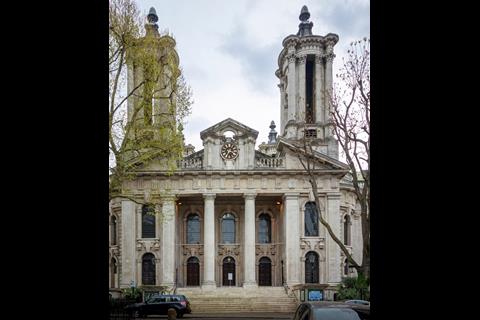Nicholas Boys Smith finds Simon Jenkins’ new book A Short History of British Architecture to be both a celebration and critique of British architecture, tracing two millennia of design while unflinchingly exposing the postwar attitudes that reshaped – and sometimes ruined – the nation’s cities

“Buildings,” wrote John Betjeman, are “a public art gallery which is always open.” Simon Jenkins has spent a lifetime in the gallery, arguing against the despoliation of London in the 1970s and chronicling its churches, houses, stations, and cathedrals.
Writing good popular history is a learned art, and Simon Jenkins has mastered it: the capacity to read thousands of pages, to consider hundreds of buildings, to distil 60 years of experience; to select facts and citations with an eye to the startling and to weave coherent and memorable stories where there might otherwise be just a tissue of chaos. The first two-thirds of A Short History of British Architecture is an enjoyably readable romp through two thousand years of architectural history. ‘Unputdownable,’ as journalists used to write. He’s particularly good on London and Wales.
The selection of points is not careless. My favourite theme is architects’ infinite capacity to squabble while all the time agreeing on the fundamentals – on the need for buildings to touch the heart and lift the soul. As one of the progenitors of Gothic buildings, Abbot Suger, put it on the doors of St Denis, “the dull mind rises to truth through that which is material.” Buildings matter.
Jenkins’s story highlights the importance of streets in creating convivial cities and of pattern books in bringing good architecture to the masses. He stresses the – to modern readers surprising – consistency with which famous architects of the past designed buildings in the ‘wrong’ style, not parroting the zeitgeist but echoing what was there before or responding to clients’ preferences in a way that would now be condemned as ‘pastiche’: Christopher Wren’s Gothic gatehouse at Christ Church, Oxford; William Adam and Roger Morris’s Inveraray Castle; Nicholas Hawksmoor’s Gothic quadrangle at All Souls and towers at Westminster Abbey (though with broken classical pediments crowning the clock faces). Gilbert Scott switched from Venetian Gothic to Italian Renaissance to please Lord Palmerston at the Foreign Office. Charles Barry did the reverse at the Palace of Westminster. Jenkins compares the ceiling ribs of a cathedral with the evolution of the baroque, citing Olive Cook on “the affinity between the two great architectural expressions of the same faith.”
The book’s last third is more important. Echoing Gavin Stamp’s recent posthumous study on interwar architecture, Jenkins is the first popular historian to treat the inventive and richly textured traditions of early twentieth-century classicism seriously, sympathetically, and as a living tradition, not as “a style on its way out.” Edwardian civic and city architecture is met with amused goodwill: one doorway by John Belcher is “not so much baroque as all-in wrestling.”
Jenkins catalogues the crimes inflicted by what he sees as the cult of traffic modernism on the charm, liveability, and sustainability of our streets and squares. It is the most urgent and moving part of the book. If you are pressed for time, read the last five chapters. He is not forgiving. “The misjudgements of the three decades of postwar urban renewal were never investigated. Billions of pounds were wasted, notably in demolishing recently constructed buildings. The misery caused almost exclusively to poor communities was beyond calculation.”
Jenkins evolves from historian to witness, and the book transforms into a source in its own right – part narrative, part summary of his own role, perceptions, and recollections of the fight to save British towns from the threat of what Jan Gehl has subsequently called “driving architecture.” The unseaming of British towns from the nave to the chops now seems barely credible. Birmingham, Glasgow, Newcastle, and many more were all unstitched and impoverished by urban motorways and acres of heartless, needless, and recklessly expensive demolition.
If we are to fall back in love with the future, to build the homes and the sustainable and resilient places that we need, then we need to be a little more humble and much more willing to create buildings that speak to the heart and to the soul
Central London nearly went the same way. Covent Garden, Piccadilly Circus, The Strand, Whitehall, much of Soho and Fitzrovia – all were to go. All were to be levelled to make way for the “motorway box” that was to desecrate central London. Jenkins was there. He tells the important story of the saving of London with passionate insistence. Next time you are tempted to complain about a NIMBY, remember that the NIMBYs saved London from a brutalist immolation. Nothing is more dangerous than a profession untouched by self-doubt. “I still find it hard to persuade people that, had it not been for the counter-revolution of the 1970s, Britain’s cities would have looked more like the Shard than like Borough Market.”
This book will be under many Christmas trees. It will be widely reviewed and discussed. But it will not be popular everywhere. Jenkins’s criticism of what developers, planners, and architects did to British towns and cities is unrelenting. I would almost be more forgiving. Against the backdrop of war and destruction, it’s hardly surprising that many wished to start afresh. But, as public unease turned into widespread revulsion, too many learnt to be instinctively dismissive of popular tastes. One high priest of traffic-modernism, Maxwell Fry, wrote that architects should address “ourselves only to those capable of understanding us, and let the rest go hang.” When Prince Charles attacked post-war architecture, the brutalist Owen Luder, President of the Royal Institute of British Architects, told colleagues to ignore him and just say “sod you.” Recent dismissive responses by some to politicians’ growing interest in creating new buildings that people actually like or to the growing evidence (in neuroscience, polling, and pricing) on the types of places that people prefer are in the same depressing tradition.
If we are to fall back in love with the future, to build the homes and the sustainable and resilient places that we need, then we need to be a little more humble and much more willing to create buildings that speak to the heart and to the soul. By looking back, Jenkins shows us how to move forward and makes a passionate case for the importance of architectural understanding. That is not bad for a page-turner.
>> Also read: Interwar: Gavin Stamp’s tribute to Britain’s forgotten architectural diversity
Postscript
A Short History of British Architecture: From Stonehenge to the Shard by Simon Jenkins is published by Penguin.
Nicholas Boys Smith is the founder and chairman of Create Streets.























1 Readers' comment